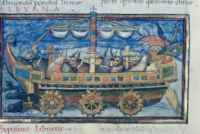- De rebus bellicis
-
 A four-wheeled ballista drawn by armored horses, from an engraving illustrating the 1552 editio princeps of De Rebus Bellicis.
A four-wheeled ballista drawn by armored horses, from an engraving illustrating the 1552 editio princeps of De Rebus Bellicis.

This article is part of the series on:
Military of ancient Rome (portal)
753 BC – AD 476Structural history Roman army (unit types and ranks, legions, auxiliaries, generals) Roman navy (fleets, admirals) Campaign history Lists of wars and battles Decorations and punishments Technological history Military engineering (castra, siege engines, arches, roads) Political history Strategy and tactics Infantry tactics Frontiers and fortifications (limes, Hadrian's Wall) De rebus bellicis is a 4th or 5th century anonymous work about war machines used by the Roman army of the time. It was written after the death of Constantine I (337; explicitly states that Constantine was dead when the work was written), and before the fall of the Western Roman Empire (476). Some researchers suggest that it may refer to the Battle of Adrianople (378; speaks about the serious threat posed by the barbarian tribes to the empire), or even the death of Emperor Theodosius I (395; in many cases it uses the plural form of the word "princeps", the title of the emperor, which may refer to the split of the Empire between Honorius and Arcadius after the death of Theodosius).
Editions
- Anonymi Auctoris De Rebus Bellicis. recensvit Robert I. Ireland (Bibliotheca scriptorvm Graecorvm et Romanorvm Tevbneriana), Lipsiae, 1984.
- "Anónimo Sobre Asuntos Militares", Edited, trans. and comm. by Álvaro Sánchez–Ostiz (EUNSA), Pamplona, 2004.
Further reading
- Hartwin Brandt, Zeitkritik in der Spätantike. Untersuchungen zu den Reformvorschlägen des Anonymus De rebus bellicis (Munich 1988) (Vestigia 40).
- J. H. W. G. Liebeschuetz, "Realism and Phantasy: The Anonymous De Rebus Bellicis and Its Afterlife," in Idem. Decline and Change in Late Antiquity: Religion, Barbarians and their Historiography (Aldershot, Ashgate, 2006) (Variorum Collected Studies).
- E. A. Thompson, A Roman Reformer and Inventor: Being a new Text of the Treatise De Rebus Bellicis with Translation and Introduction (Oxford 1952).
Categories:- 4th-century books
- Latin military books
- Military technology books
Wikimedia Foundation. 2010.

